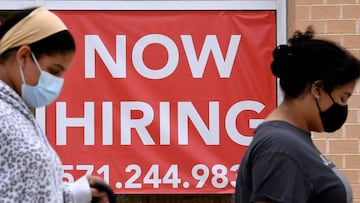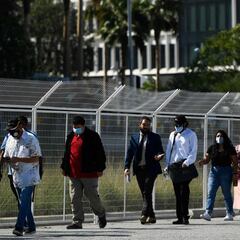What was the unemployment level in each state when federal unemployment programs ended?
The extra unemployment benefits during the pandemic were ended federally on Labor Day, but that doesn't mean the rate has returned to pre-pandemic levels.


On Friday, the US Bureau of Labor Statistics released their employment summary for August 2021. Overall, the national unemployment rate fell by 0.2 percent to 5.2 percent, a decrease on August 2020 by 3.2 percent.
Nonfarm payroll employment increased in 11 states but decreased in three states, and was essentially unchanged in 36 states and the District of Columbia in August 2021. Over the year, 49 states and the District added nonfarm payroll jobs and one state was basically unchanged.
These statistics do not yet take into account the impact of the end of the extra unemployment benefits on Labor Day. Those statistics will be released in a months time.
What about individual states?
The full list of states' unemployment rates, including the District of Columbia, can be found below.
List of US states with unemployment rates (in percent)
| Name of State | July 2021 | August 2021 | Percentage change |
| Alabama | 3.2 | 3.1 | -0.1 |
| Alaska | 6.6 | 6.4 | -0.2 |
| Arizona | 6.6 | 6.2 | -0.4 |
| Arkansas | 4.3 | 4.2 | -0.1 |
| Califronia | 7.6 | 7.5 | -0.1 |
| Colorado | 6.1 | 5.9 | -0.2 |
| Connecticut | 7.3 | 7.2 | -0.1 |
| Delaware | 5.6 | 5.4 | -0.2 |
| District of Columbia | 6.7 | 6.5 | -0.2 |
| Florida | 5.1 | 5.0 | -0.1 |
| Georgia | 3.7 | 3.5 | -0.2 |
| Hawaii | 7.3 | 7.0 | -0.3 |
| Idaho | 3.0 | 2.9 | -0.1 |
| Illinois | 7.1 | 7.0 | -0.1 |
| Indiana | 4.1 | 4.1 | 0 |
| Iowa | 4.1 | 4.1 | 0 |
| Kansas | 3.8 | 3.8 | 0 |
| Kentucky | 4.4 | 4.3 | -0.1 |
| Louisiana | 6.6 | 6.2 | -0.4 |
| Maine | 4.9 | 4.9 | 0 |
| Maryland | 6.0 | 5.9 | -0.1 |
| Massachusetts | 4.9 | 5.0 | +0.1 |
| Michigan | 4.8 | 4.7 | -0.1 |
| Minnesota | 3.9 | 3.8 | -0.1 |
| Mississippi | 6.1 | 6.0 | -0.1 |
| Missouri | 4.2 | 4.0 | -0.2 |
| Montana | 3.6 | 3.5 | -0.1 |
| Nebraska | 2.3 | 2.2 | -0.1 |
| Nevada | 7.7 | 7.7 | 0 |
| New Hampshire | 2.9 | 3.0 | +0.1 |
| New Jersey | 7.3 | 7.2 | -0.1 |
| New Mexico | 7.6 | 7.2 | -0.4 |
| New York | 7.6 | 7.4 | -0.2 |
| North Carolina | 4.4 | 4.3 | -0.1 |
| North Dakota | 3.9 | 3.6 | -0.3 |
| Ohio | 5.4 | 5.4 | 0 |
| Oklahoma | 3.5 | 3.2 | -0.3 |
| Oregon | 5.2 | 4.9 | -0.3 |
| Pennsylvania | 6.6 | 6.4 | -0.2 |
| Rhode Island | 5.8 | 5.8 | 0 |
| South Carolina | 4.3 | 4.2 | -0.1 |
| South Dakota | 2.9 | 2.9 | 0 |
| Tennessee | 4.7 | 4.6 | -0.1 |
| Texas | 6.2 | 5.9 | -0.3 |
| Utah | 2.6 | 2.6 | 0 |
| Vermont | 3.0 | 3.0 | 0 |
| Virginia | 4.2 | 4.0 | -0.2 |
| Washington | 5.1 | 5.1 | 0 |
| West Virginia | 5.0 | 4.8 | -0.2 |
| Wisconsin | 3.9 | 3.9 | 0 |
| Wyoming | 5.2 | 4.9 | -0.3 |
Nevada had the highest unemployment rate in August at 7.7 percent, followed by California and New York, 7.5 percent and 7.4 percent, respectively. Nebraska had the lowest jobless rate, 2.2 percent, which was also a new low for the state since records began in 1976.
In total, 22 states had unemployment rates lower than the US average of 5.2 percent. 13 states and the District of Columbia had higher rates.
Arizona, Louisiana, and New Mexico had the largest over-the-month unemployment rate decreases at -0.4 percentage point each. Other states with big falls were Hawaii, North Dakota, Oklahoma, Oregon, Texas and Wyoming with a decrease of -0.3 percentage points.
Related news:
- Why won't states extend unemployment benefits, as was proposed by Biden?
- Will AOC’s bill extend pandemic unemployment insurance until 2022?
- In which states did unemployment claims increase last week?
- How many people have lost federal unemployment benefits in New York?
Will the end of the extra unemployment benefits have an effect in the September report?
The end of the extra benefits comes with the hope of a renewed push for employment. However, many fears still abound in workers minds before they can return to work. For one, the continued prevalence of covid-19 in the country is scaring many from returning.
Related stories
On Thursday, 16 September, the Bureau of Labor Statistics reported the first increase in initial unemployment benefit claims in weeks. Last week, initial claims rose by 20,000 to 32,000. This could be foreboding for a rise in unemployment before Christmas.
Employers and economists expected a spike in job applications after enhanced unemployment benefits expired on Sept. 6. That hasn't happened: https://t.co/LwT3SmzH92 (w/ @katiadmi)
— Olivia Rockeman (@livrockeman) September 20, 2021
Businesses are also finding it struggle to employ more people. Despite a forecast of 750,000 new jobs in August, the US economy could barely muster just over a third of that, 235,000. It's the lowest total since January

